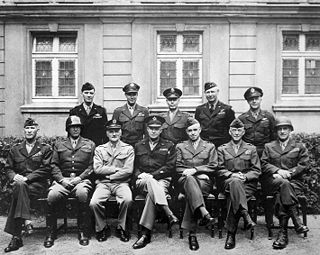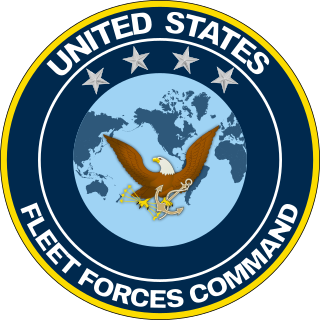Talon or talons may refer to:
Captain is a rank or title for commander of a military unit, commander of a ship or other vessel, or leader of a unit or organization.
Barbarossa, a name meaning "red beard" in Italian, primarily refers to:

Red Storm Rising is a war novel, written by Tom Clancy and co-written with Larry Bond, and released on August 7, 1986. Set in the mid-1980s, it features a Third World War between the North Atlantic Treaty Organization and Warsaw Pact forces, and is unique for depicting the conflict as being fought exclusively with conventional weapons, rather than escalating to the use of weapons of mass destruction or nuclear warfare. It is one of two Clancy novels, along with SSN (1996), that are not set in the Ryanverse.

The European Theater of Operations, United States Army (ETOUSA) was a theater of Operations responsible for directing United States Army operations throughout the European theatre of World War II, from 1942 to 1945. It commanded Army Ground Forces (AGF), United States Army Air Forces (USAAF), and Army Service Forces (ASF) operations north of Italy and the Mediterranean coast. It was bordered to the south by the North African Theater of Operations, United States Army (NATOUSA), which later became the Mediterranean Theater of Operations, United States Army (MTOUSA).

The United States Fleet Forces Command (USFF) is a service component command of the United States Navy that provides naval forces to a wide variety of U.S. forces. The naval resources may be allocated to Combatant Commanders such as United States Northern Command (USNORTHCOM) under the authority of the Secretary of Defense. Originally formed as United States Atlantic Fleet (USLANTFLT) in 1906, it has been an integral part of the defense of the United States of America since the early 20th century. In 2002, the Fleet comprised over 118,000 Navy and Marine Corps personnel serving on 186 ships and in 1,300 aircraft, with an area of responsibility ranging over most of the Atlantic Ocean from the North Pole to the South Pole, the Caribbean Sea, Gulf of Mexico, and the waters of the Pacific Ocean along the coasts of Central and South America.

The Seventh Fleet is a numbered fleet of the United States Navy. It is headquartered at U.S. Fleet Activities Yokosuka, in Yokosuka, Kanagawa Prefecture, Japan. It is part of the United States Pacific Fleet. At present, it is the largest of the forward-deployed U.S. fleets, with 50 to 70 ships, 150 aircraft and 27,000 Sailors and Marines. Its principal responsibilities are to provide joint command in natural disaster or military operations and operational command of all US naval forces in the region.
Pacific Theatre or Pacific Theater may refer to:

The Naval War College is the staff college and "Home of Thought" for the United States Navy at Naval Station Newport in Newport, Rhode Island. The NWC educates and develops leaders, supports defining the future Navy and associated roles and missions, supports combat readiness, and strengthens global maritime partnerships.
Eastern Front may refer to
Hannibal was a Carthaginian general who fought the Roman Republic in the Second Punic War.
Armada is the Spanish and Portuguese word for naval fleet. Armáda is the Czech and Slovak word for armed forces.
A unified combatant command, also referred to as a combatant command (CCMD), is a joint military command of the United States Department of Defense that is composed of units from two or more service branches of the United States Armed Forces, and conducts broad and continuing missions. There are currently 11 unified combatant commands, and each is established as the highest echelon of military commands, in order to provide effective command and control of all U.S. military forces, regardless of branch of service, during peace or during war time. Unified combatant commands are organized either on a geographical basis or on a functional basis, e.g., special operations, force projection, transport, and cybersecurity. Currently, seven combatant commands are designated as geographical, and four are designated as functional. Unified combatant commands are "joint" commands and have specific badges denoting their affiliation.
Front line refers to the forward-most forces on a battlefield.
Silver is a chemical element with symbol Ag and atomic number 47.

Commander, U.S. Fleet Forces Command (COMUSFF/COMFLTFORCOM) is the title of the United States Navy officer who serves as the commanding officer of the United States Fleet Forces Command. The U.S. Fleet Forces Command was originally established in 1905 as the U.S. Atlantic Fleet and as a two-star rear admiral's billet; the position has been held by a four-star admiral since March 10, 1915. The 45th, and current, commander of U.S. Fleet Forces Command is Admiral Daryl L. Caudle.
Supreme Commander may refer to:

Charles Quinton Brown Jr. is a United States Air Force general who is serving as the 21st chairman of the Joint Chiefs of Staff since October 1, 2023. He most recently served as the 22nd chief of staff of the Air Force from 2020 to 2023. Brown entered the Air Force in 1984. A fighter pilot, he has logged over 3,000 flight hours, including 130 hours in combat. He has commanded the Pacific Air Forces, U.S. Air Forces Central Command, 31st Fighter Wing, 8th Fighter Wing, U.S. Air Force Weapons School, and 78th Fighter Squadron. He has also served as deputy commander of the U.S. Central Command.
Captain is a title, an appellative for the commanding officer of a military unit; the supreme leader of a navy ship, merchant ship, aeroplane, spacecraft, or other vessel; or the commander of a port, fire or police department, election precinct, etc. In militaries, the captain is typically at the level of an officer commanding a company or battalion of infantry, a ship, or a battery of artillery, or another distinct unit. The term also may be used as an informal or honorary title for persons in similar commanding roles.






